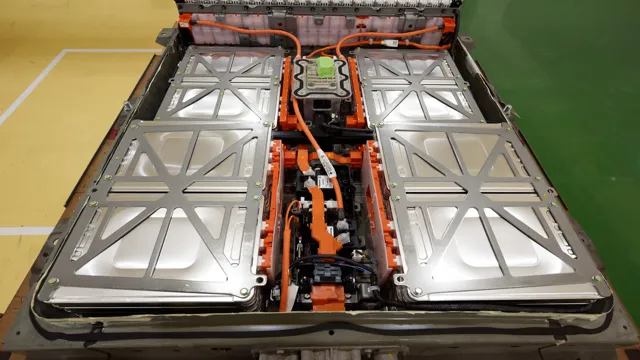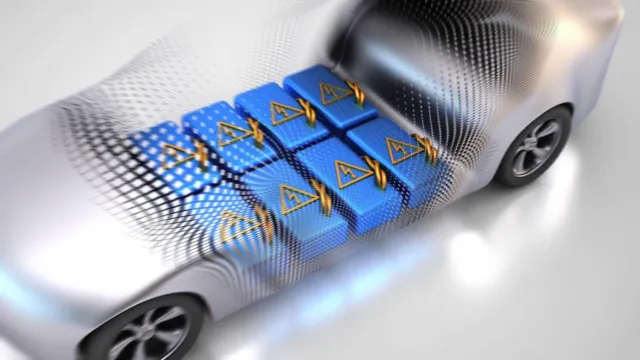The Electrifying Evolution of Electric Car Batteries: A Fascinating Look at Their History
As we move towards a more eco-friendly future, electric cars have become a popular choice for their zero-emission capabilities. However, what is often overlooked is the history of electric car batteries and how they have evolved over time. Did you know that the first electric car was invented in 1832 and ran on non-rechargeable batteries? It wasn’t until the 1900s that rechargeable batteries were introduced, but they were still bulky and expensive, making electric cars a luxury item.
Fast forward to modern times, and electric car batteries have become much more efficient and affordable, allowing for wider adoption of electric vehicles. But how did we get to this point? Join us as we dive into the exciting history of electric car batteries and how they have revolutionized the automotive industry.
Early Electric Car Batteries
Electric car battery history is fascinating, and it all began in the 1800s when inventors started experimenting with various battery types to power electric vehicles. Early batteries like the lead-acid battery were heavy and had limited energy storage capacity, making them unsuitable for widespread use. Later, nickel-iron, nickel-cadmium, and even sodium-sulfur batteries made an appearance, but all had their limitations, including high cost, low power density, and instability.
The breakthrough finally came in the 1990s with the introduction of the lithium-ion battery, which is lighter, has a higher energy storage capacity, and is more stable than its predecessors. Today, electric vehicles continue to rely on lithium-ion batteries, which have come a long way in terms of efficiency and cost-effectiveness. As technology continues to advance, the future of electric car batteries looks bright, with more efficient and affordable options on the horizon.
Lead-acid batteries dominated in the 19th and 20th centuries
When it comes to the early days of electric cars, lead-acid batteries were the go-to choice for powering these vehicles. In fact, these batteries dominated the industry for both the 19th and 20th centuries. Lead-acid batteries were favored for their ability to produce high currents and provide the necessary power to electric motors for a decent amount of time.
However, they did have some drawbacks, such as their heavy weight, short lifespan, and the need for regular maintenance. Despite these issues, lead-acid batteries paved the way for the development of modern electric vehicle batteries and the push towards cleaner, more sustainable transportation options. Today, we have a range of battery technologies to choose from, including lithium-ion and solid-state batteries that offer longer lifespans, higher energy densities, and faster charging times.
Nonetheless, it’s important to remember the crucial role that lead-acid batteries played in the early days of electric cars and their impact on the evolution of modern electric vehicle batteries.

Early EVs ran for only a short distance
Early electric cars were limited in range due to the batteries they used. These early EVs typically ran on lead-acid batteries, which were heavy and had a short lifespan. Typically, lead-acid batteries could only power an electric car for around 50 miles before needing to be recharged.
Furthermore, they were not very efficient and took a long time to recharge. The poor range and charging times limited the practicality of early electric vehicles and made them unsuitable for long-distance travel. However, in recent years, significant improvements have been made in battery technology, and modern electric cars can travel hundreds of miles on a single charge.
Nevertheless, the limitations of early electric car batteries were an important obstacle to the widespread adoption of EVs in the early 20th century.
Recent Advancements in Electric Car Batteries
The history of electric car battery technology dates back over a century. Early batteries were bulky and inefficient, limiting the practicality of electric vehicles. However, in recent years, there have been significant advancements in battery technology, making electric cars more efficient and practical.
Lithium-ion batteries have become the preferred choice for powering electric vehicles due to their high power-to-weight ratio, durability, and energy density. Solid-state batteries, which use a solid electrolyte instead of a liquid one, are on the horizon and are projected to offer even greater performance benefits such as faster charging times, longer lifetimes, and higher energy densities. These advancements in electric car battery technology are not only making electric cars more efficient but are also making them more accessible and affordable for a wider range of consumers.
2010s introduced Lithium-ion batteries as a more reliable option
The electric car industry has come a long way in recent years, and much of that progress can be traced back to advancements in battery technology. One of the biggest changes is the introduction of Lithium-ion batteries as a more reliable option. Compared to their predecessors, these batteries are energy-dense and have a longer lifespan.
This means that electric cars can go further on a single charge, and drivers can expect their batteries to last longer before needing to be replaced. In addition to these improvements, there have also been developments in fast-charging technology, which makes it even more convenient to own an electric car. Overall, these advancements are making sustainable transportation more accessible and practical for everyday drivers.
Tesla’s Gigafactory has significantly increased production capabilities
The advancements in electric car batteries have been remarkable in recent years, and the Gigafactory by Tesla has been one of the major players in this field. Tesla’s Gigafactory, located in Nevada, has significantly increased production capabilities and has also reduced the cost of lithium-ion batteries. The factory has also enabled Tesla to increase the range of their electric cars and has made them more affordable to the average consumer.
The reduction in the cost of batteries means that the cost of electric cars will continue to decrease, making them a more viable option compared to traditional gas-powered vehicles. With Tesla’s Gigafactory leading the way, other major automakers are also investing heavily in developing more advanced electric car batteries. The future seems promising for clean energy vehicles, and it’s exciting to see how technology will continue to evolve to make them even more efficient and practical.
Solid-state batteries are the next step
Solid-state batteries are the next step in the evolution of electric car batteries and have been gaining a lot of attention recently. These batteries use solid electrolytes instead of the liquid electrolytes found in traditional lithium-ion batteries. The result is a battery that is safer, faster charging, and has a higher energy density than current battery technology.
In fact, solid-state batteries could potentially double the driving range of electric vehicles. The use of solid-state batteries would also eliminate the risk of fires caused by overheating liquid electrolytes, which have been an issue in some electric cars. While the technology is still in development, several companies, including Toyota and BMW, are already working on solid-state battery prototypes.
Once this technology becomes commercially viable, it could be a game-changer for the electric car industry.
Future of Electric Car Batteries
Electric car battery history is a fascinating story of innovation, challenges, and breakthroughs. The evolution of batteries for electric cars began with lead-acid batteries, which were heavy and limited in range. However, they were readily available and affordable at the time.
Then came nickel-cadmium batteries, which were lighter and had better energy density than lead-acid batteries. However, cadmium is a toxic material that poses a threat to the environment. Therefore, the development of nickel-metal-hydride batteries followed, which were safer and more reliable.
Today, lithium-ion batteries are the most common type of electric car batteries. They have high energy density, low weight, and long lifespan. However, researchers and manufacturers are continually working to improve electric car batteries, with the aim of making them even more efficient, affordable, and environmentally friendly.
New developments, such as solid-state batteries, have the potential to revolutionize the electric car industry and disrupt the traditional automotive market.
Batteries with longer ranges and shorter charging times will become the norm
The future of electric car batteries looks bright with longer range capabilities and shorter charging times becoming the norm. As battery technology continues to advance, manufacturers are working to create electric cars that can travel further distances without needing to be recharged as frequently. Not only will this increase the convenience of owning an electric car, but it will also alleviate concerns around “range anxiety” – the fear that one’s electric car will run out of battery before reaching their destination.
Shorter charging times will also make electric cars more practical for everyday use, allowing drivers to make quick pitstops instead of waiting around for hours as their car charges. As electric car batteries improve, it is likely that more people will consider making the switch from traditional gasoline-powered vehicles, driving us towards a greener, more sustainable future.
Investments in new battery technology will continue
As electric cars become more mainstream, advancements in battery technology will play a crucial role in their widespread adoption. Companies investing in such technology will continue to propel the industry even further. The future of electric car batteries is set to become even more exciting, promising greater range, faster charging, and more affordable pricing.
One important aspect being developed is solid-state batteries, which use a solid electrolyte rather than a liquid one like in traditional lithium-ion batteries. Solid-state batteries can potentially store more energy, are less prone to overheating, and are safer than traditional batteries. The benefits of investing in this type of technology are immense.
Battery technology is rapidly evolving, making it an exciting time for both electric car enthusiasts and investors to get on board. With a continued focus on research and development, the future of electric car batteries holds immense promise to revolutionize the automobile industry in unimagined ways.
Conclusion
As we look back on the history of electric car batteries, one thing becomes clear: innovation and evolution have been the driving force behind their success. From the early days of bulky lead-acid batteries to the sleek and efficient lithium-ion batteries of today, the electric vehicle industry has been a story of constant progress and advancement. And as we continue to embrace cleaner and sustainable transportation solutions, the future is shaping up to be an electrifying one.
“
FAQs
When was the first electric car battery invented?
The first electric car battery was invented in 1859 by French physicist Gaston Planté.
What is the history behind the development of electric car batteries?
The development of electric car batteries dates back to the 19th century, when researchers started experimenting with lead-acid batteries for electric vehicles.
What are the different types of electric car batteries available in the market?
The most common types of electric car batteries available in the market today are lithium-ion batteries, nickel-metal hydride batteries, and lead-acid batteries.
How has the performance of electric car batteries improved over the years?
With the advancements in technology, the performance of electric car batteries has improved significantly over the years. Modern electric car batteries have longer driving ranges, faster charging times, and improved durability.





